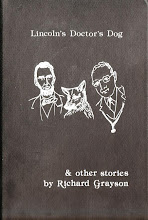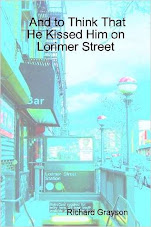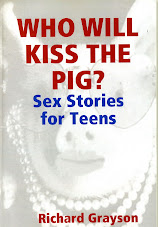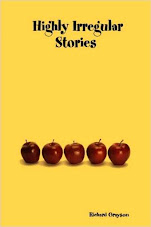 The prolific author Jack Saunders reviews Richard Grayson's two Dumbo Books short story collections for the Underground Literary Alliance's Outsider Writers' Book Review
The prolific author Jack Saunders reviews Richard Grayson's two Dumbo Books short story collections for the Underground Literary Alliance's Outsider Writers' Book Review:
Richard Grayson: Highly Irregular Stories; And To Think that He Kissed Him on Lorimer Street and Other Stories
Reviewed by: Jack Saunders Jack Saunders has met Richard Grayson, and Richard has met Jack.Highly Irregular Stories (2006) and And to Think That He Kissed Him on Lorimer Street and Other Stories (2006), by Richard Grayson. Dumbo Books of Brooklyn, 72 Conselyea St., Brooklyn, NY 11211-2211. dumbobooks@yahoo.com
And to Think That He Kissed Him on Lorimer Street and Other Stories is Richard Grayson’s 10th volume of fiction. Or metafiction. Or autobiography. Or stand-up comedy. Or short form narrative. He’s published two other books. What are they? Nonfiction? Reportage? I always think of Jonathan Winters saying he is in gar-bahj, when I hear re-por-tahj.
I believe you could call the writing avant-garde. It’s out ahead of the pack. The avant-garde is a tradition, like any other. Like commercial fiction, or literary fiction. It’s anti-commercial. Anti-literary. The literary is a set of conventions an iconoclast wants to bust up.
An iconoclast is aware of his place in the scheme of things. He knows the history of what he’s doing. He is aware, or self-aware, and self-awareness leads to irony.
Irony lends itself to short pieces. You don’t want to be long-winded. That’s for novels, a more expansive form, where you can stretch out. In one sense, you could say the avant-garde leads the way. In another, profounder sense, you could say it doesn’t go anywhere, it just is. It is what it is. Take it or leave it. As it is. This makes reviewing a collection of short pieces either very easy or very hard.
What is the author trying to do, and is he succeeding, on his own terms? Larry wrote the other day that he found himself at looking at books in a rummage sale, and found he was reading them to see what bias they had; not to see what the book was about or to read for enjoyment or to get taken up by it.
What happens when we approach books like that? How do we not approach books like that?
Do collections of stories become something in the aggregate they were not, separately, as lone stories, in magazines that pay in copies and go belly up, or self-published chapbooks, issued in editions of hundreds of copies? Are they clever, amusing, cute? Do they hold up? Do we see a design to the works, over time? A pattern? Is a collection of them more impressive, more authentic, does it have a gravitas scattered fragments cannot demonstrate? Are we impressed? Are we surprised? Did we disremember? Do we see things we didn’t see the first time through?
You can buy the books from lulu.com for $12.95 or $16.95.
Highly Irregular Stories is a collection of four chapbooks, which are out of print, and rare. A copy of
Eating at Arby’s was recently listed online at $350. It’s good to see the stuff back in print. The stories in
And to Think That He Kissed Him on Lorimer Street haven’t been collected before. It’s nice to see them in one spot.
What is One Life in the Short Form Narrative Business like? We get a good feel for it, in these two collections, which span three decades.
What is America like? It’s like Richard Grayson says it is, it’s how Richard Grayson sees it. He’s a Jew from Brooklyn, I’m a cracker from Delray Beach. We have different accents, different life-experiences, different expectations, about life. I’m older than he is, and was in the Air Force for eight years. I boxed. I went ten rounds with Bukowski. I fought the Creature from the Black Lagoon underwater, at Wakulla Springs.
Now I just sit around and watch my boot turn blue, from mildew.
But his America rings true, to me, a deep and eclectic literary sensibility in a pop-culture milieu of glitz and flash, the shallow and the hyped, pinball-machine moths, attracted to the light, the noise, the buzz. Love-bugs, smashed on the windscreen. In the throes of their mating ritual. Up around Gainesville on a two-lane blacktop. Harry Crews afraid to leave his writing studio because he might miss something. And Harry Crews ain’t afraid of death or taxes.
A reader said he kept my books on the back of the crapper, and he started every day with a good old country shit and a belly laugh.
That’s a good thing to do with Richard Grayson’s books. Keep them on the back of the crapper and read them every day. They will make you laugh. The stories are short enough you can read one at a sitting.
My theory is that we are attracted to a writer’s voice, and every time we find a writer we like, we buy everything by him or about him we can find, regardless of genre. If he’s any good, he has invented his own genre, conflated one or more genres into a form of his own, which we recognize, because of his distinctive voice.
Bud Powell had small hands. Mary Lou Williams had hands that looked like $10 worth of spareribs in 1937. They’re not going to sound the same. Why should they? If the short pieces have a unity of form, a consistency of vision, a continuity of effort, a tone, an outlook, when do they begin to be less self-contained short pieces and constituent parts of a longer work composed of short pieces, if they do? If they do, was it an accident?
Public taste is fickle. A writing career is a tradeoff and a crapshoot. You can make a fortune writing but not a living. Not even the living you’d make at more mundane tasks. You have to have a sense of humor about it.
A sense of black humor, like the old comics Lenny Bruce, Mort Sahl, and Shelley Berman. The writers Woody Allen, Richard Brautigan, and Terry Southern. Would you choose writing for a career? You don’t choose it, it chooses you. What if you choose it and it doesn’t choose you?
Can you be funny about that? For 30 years? It’s not as easy as Richard Grayson makes it look.
The stories in the second book are newer and darker than the stories in the first book. Branch libraries are closed, movie houses shut down, neighborhoods gentrified, people moved away, friends died, what was not there, then was new, and ugly, is now shabby, with people hanging on, because they have no choice. There are constants. The stock market rises and falls, real estate goes up, people have careers, careers have an arc, not all careers have the same arc.
Richard Grayson once observed to me that writers advise you to do what they did. If they teach writing, they advise you to teach writing. If they are some other kind of professional, they advise you to be some other kind of professional. He was a lawyer. Journalists advise people to write for newspapers or magazines. Or television. I was a paraprofessional. A technical writer. Not an engineer or a programmer. On a par with a draftsman or a logistician (supply specialist). A white collar job, but not a full-fledged profession.
What is true is you need a job that pays enough so you can live comfortably, and are not so tired by your work that you are too tired to write, after work. And that can mean too tired emotionally. Then you just do your job and write before and after work. Or during work.
Maybe you’ll have a year off now and then, when you win a grant, inherit some money, or, in my case, once, are able to draw 49 weeks of separation pay, unemployment, and extended unemployment benefits, plus social security, or, another time, cash in the retirement you rolled over into an annuity when your last corporate employer laid you off and live on that for a year. Or mortgage the house you inherited when your grandfather died and run up the balance on a line-of-credit home-equity loan.
I’m always curious about how a writer supported himself when he wrote the books, and think that should go in the books. I think a reader has a right to know that.
Did he kiss a Stalinist’s ass in Macy’s window?
I enjoyed reading these books and I think you will too. I think they’re worth going to some trouble to find out about and buy. And tell your friends about.
And tell the author about them, if you liked them.






























































